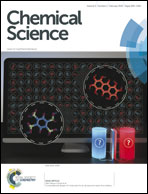Intramolecular ring-opening from a CO2-derived nucleophile as the origin of selectivity for 5-substituted oxazolidinone from the (salen)Cr-catalyzed [aziridine + CO2] coupling†
Abstract
The (salen)Cr-catalyzed [aziridine + CO2] coupling to form oxazolidinone was found to exhibit excellent selectivity for the 5-substituted oxazolidinone product in the absence of any cocatalyst. Quantum mechanical calculations suggest that the preferential opening of the substituted C–N bond of the aziridine over the unsubstituted C–N bond is a key factor for this selectivity, a result that is supported by experiment with several phenyl-substituted aziridines. In the presence of external nucleophile such as dimethyl aminopyridine (DMAP), the reaction changes pathway and the ring-opening process is regulated by the steric demand of the nucleophile.
![Graphical abstract: Intramolecular ring-opening from a CO2-derived nucleophile as the origin of selectivity for 5-substituted oxazolidinone from the (salen)Cr-catalyzed [aziridine + CO2] coupling](/en/Image/Get?imageInfo.ImageType=GA&imageInfo.ImageIdentifier.ManuscriptID=C4SC02785J&imageInfo.ImageIdentifier.Year=2015)

 Please wait while we load your content...
Please wait while we load your content...